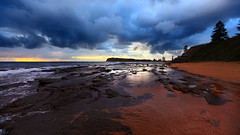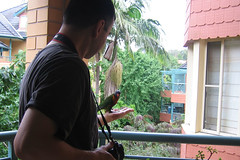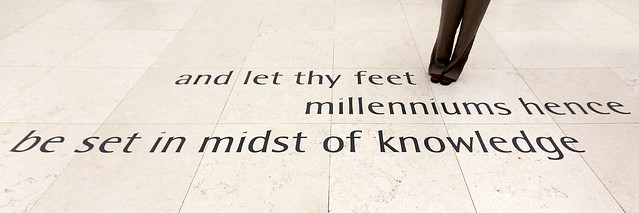I’ve begun reading Douglas Hofstadter’s book Le Ton Beau de Marot. I’m barely one chapter in, and I’m starkly reminded of just how much hard work it was to read through his earlier book, Gödel, Escher, Bach. That book required a clear state of mind, full concentration, and a considerable amount of cogitation and effort to read, to absorb, and to appreciate.
This new book is about translation between languages and the intricate interplay of semantic and structural difficulties that this problem brings to anyone who tries to do it. The book is framed around a French poem, Ma Mignonne, by the 16th century poet Clément Marot. Without having “cheated” by glancing past the first chapter, I understand that the book will present dozens of different translations into English of this one short poem, accompanied by discussions of the issues involved and the adjustments that need to be made to make one language conform to both the shape and the meaning of another.
So at the end of Chapter One, which presents a brief outline of Marot’s life, Hofstadter presents the original Ma Mignonne in French, then a handful of translations into English. These translations are more or less literal, conveying much of the meaning of the poem but failing to reproduce its structure. The chapter ends with a request to the reader to attempt your own translation of the poem into English, assuring you that you already know enough to make a first attempt. Yes, just like GEB, this book asks you to do homework. And in all fairness to the book and to Professor Hofstadter, I feel compelled to complete the homework before continuing to Chapter Two.
So I’m about to present my translation of Ma Mignonne. But first, the original poem for anyone who has never seen it:
A une Damoyselle Malade
Ma mignonne,
Je vous donne
Le bon jour;
Le séjour
C’est prison.
Guérison
Recouvrez,
Puis ouvrez
Votre porte
Et qu’on sorte
Vitement,
Car Clément
Le vous mande.
Va, friande
De ta bouche,
Qui se couche
En danger
Pour manger
Confitures;
Si tu dures
Trop malade,
Couleur fade
Tu prendras,
Et perdras
L’embonpoint.
Dieu te doint
Santé bonne,
Ma mignonne.
Here is the basic, literal translation that Hofstadter provides to get you started in understanding what this poem says:
To a Sick Damsel
My sweet
I bid you
A good day;
The stay
Is prison.
Health
Recover,
Then open
Your door,
And go out
Quickly,
For Clément
Tells you to.
Go, indulger
Of thy mouth,
Lying abed
In danger,
Off to eat
Fruit preserves;
If thou stay’st
Too sick,
Pale shade
Thou wilt acquire,
And wilt lose
Thy plump form.
God grant thee
Good health,
My sweet.
Hofstadter explicitly points out the following points of structure for this poem in Chapter One:
- The poem is 28 lines long.
- Each line consists of three syllables.
- Each line’s main stress falls on its final syllable.
- The poem is a string of rhyming couplets: AA, BB, CC, …
- The semantic couplets are out of phase with the rhyming couplets: A, AB, BC, …
- Midway, the tone changes from formal (“vous”) to informal (“tu”).
- The poem’s opening line is echoed precisely at the very bottom.
- The poet puts his own name directly into his poem.
His literal translation clearly violates most of these. He does not ask that translators adhere strictly to all of these points, but wants to make sure you’re aware of them so that if you break one, you’re doing it knowingly.
I now offer my own translation, in which I have attempted to satisfy as many of the structural elements as I can, but sacrificing some slight changes in exact semantic meaning to achieve this. This is entirely my own work. I have not yet read beyond Chapter One of Le Ton Beau de Marot, nor have I sought or seen any other attempted translations of this poem online yet – though I have no doubt at all that hundreds of them must exist as other readers attempt this task and share their efforts. So it is a wholly original composition, but I would not be surprised if some lines echo lines in other people’s versions. Without further ado:
To A Sick Girl
My dear child,
Such a mild
Day outside:
Time you bide
Is duress.
I do bless
Your swift cure,
Then the lure
Of fresh air
Shows you where
You should be;
David’s plea
Is just this.
Go, young miss
Of sweet tooth,
Ill in truth,
Under threat,
Off to get
Marmalade;
A pale shade
You will gain,
If your pain
Lasts too long,
And your strong
Form will flee.
God’s grace be
On you smiled,
My dear child.
Right. Homework completed. On the Chapter Two!
 I got up at 4:30 on Friday morning to go out to Curl Curl Beach and take some photos of the sunrise. It’s the nicest time of year to do this, and it will probably be my last chance before leaving for South America. The sunrise wasn’t great, but I got some half decent shots.
I got up at 4:30 on Friday morning to go out to Curl Curl Beach and take some photos of the sunrise. It’s the nicest time of year to do this, and it will probably be my last chance before leaving for South America. The sunrise wasn’t great, but I got some half decent shots.






